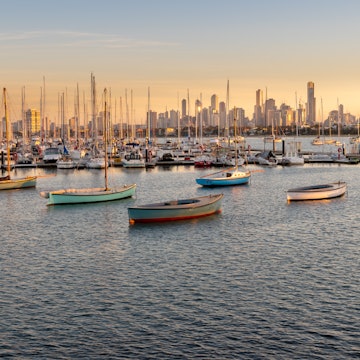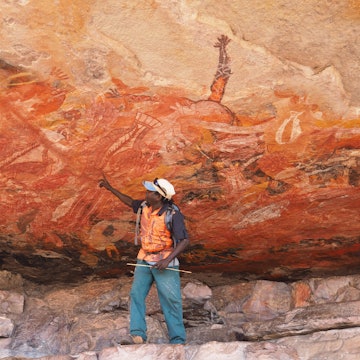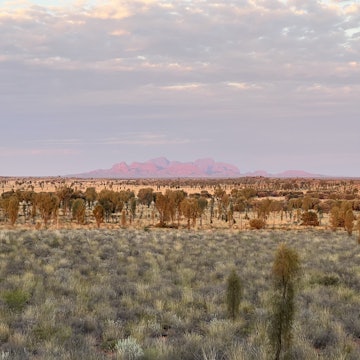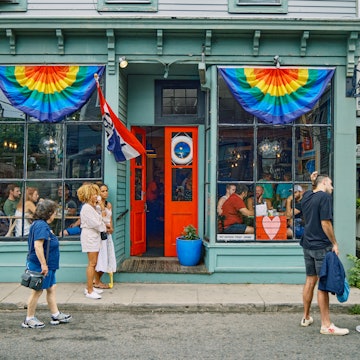

Experience Australia's Aboriginal culture as a tourist with this guide. Shutterstock
“The rainforest is like our supermarket, but we have to be careful which aisle we shop in,” chuckles Kuku Yalanji man Levi Williams, who guides visitors on cultural walks at Mossman Gorge in Queensland’s ancient Daintree Rainforest. “These things are toxic enough to kill a person within hours,” he explains, pointing to a cassowary plum on the forest floor that can only be safely ingested by the flightless bird that gave the vivid blue fruit its name.
With more than 65,000 years of ancestral knowledge to draw on, Aboriginal and Torres Strait Islander guides aren’t only experts at interpreting Australia’s wild and beautiful landscapes, they are also master storytellers, each with their own unique connection to their traditional lands. But a guided tour is just one of many ways to connect with the world’s oldest living cultures. Here’s a primer for memorable Indigenous tourism experiences in Australia.

Who are the Indigenous Australians?
Australia’s Indigenous peoples are two distinct cultural groups made up of the Aboriginal peoples of mainland Australia (and Tasmania) and Torres Strait Islander peoples from the eponymous Queensland archipelago. But there are several hundred groups within these two groups, each with their own cultures, customs, languages and laws. Language groups are commonly described as "Nations" (Levi Williams, for example, identifies as a member of the Kuku Yalanji Nation) and groups within Nations as "clans" or "mobs".
You might see terms including "Aboriginal", "Indigenous" and "First Nations" used to refer to Australia’s Indigenous peoples collectively, but terminology preferences differ between groups and individuals – when in doubt, ask.
Understanding Australia’s Indigenous cultures
Aboriginal and Torres Strait Islander cultures are diverse, yet all are centered on a connection to family, community, Country (a term that refers to traditional lands), and spirit beings on Country. The Dreaming (or Dreamtime) is commonly used to describe the complex network of Indigenous spiritual beliefs.
Aboriginal and Torres Strait Islander communities and cultures were, and continue to be, devastated by the impacts of colonization. Yet while some languages and traditions have been lost as a result of injustices including the removal of Indigenous children from their parents (known as the stolen generations), Australia’s Indigenous cultures are incredibly resilient.
“Aboriginal culture isn’t dead, it has just been sleeping in some places,” says Darren "Capes" Capewell, a descendant of the Nhanda people of Western Australia’s Shark Bay region and owner of Wula Gura Nyinda Eco Cultural Adventures. Central to Capes’ tours is sharing the local Aboriginal names of plants, animals and landscapes on Country to help preserve the language of his ancestors for future generations.

Where can I experience Aboriginal culture?
Aboriginal and Torres Strait Islander peoples currently represent less than 4% of Australia’s population, so interactions with Indigenous Australians aren’t a given for many visitors. Yet Indigenous culture is everywhere.
Just about every corner of Australia (including its Sea Country) lies on the traditional lands of an Indigenous group known as the Traditional Custodians or Owners of that region. Many Australian towns and cities have an Indigenous cultural center, museum or art center where you can learn about the Traditional Custodians of the Country you’re visiting, while major cultural museums are found in every capital city, such as the Australian Museum in Sydney (Warrane) and the National Museum of Australia in Canberra.
But who better to introduce you to Australia’s rich Indigenous cultures than somebody who lives and breathes their culture every day? Indigenous guided tours are available all over Australia, from remote national parks to the streets of Melbourne (Narrm), and many experiences are suitable for children, seniors and people with disabilities. Platforms including Welcome to Country and Discover Aboriginal Experiences make it easy to search and book.
What happens on an Aboriginal tour?
Indigenous tourism is constantly evolving. Where in decades past you may have observed a mock corroboree (ceremonial meeting) or had a go at throwing a boomerang, Indigenous cultures can now be experienced in many different and meaningful ways.
Some experiences take the form of low-impact and family-friendly walking tours, with storytelling and opportunities to sample bush foods, which is always a hit with kids big and small. Male visitors to northern Australia might be invited to learn how to produce the pulsating drone of the wind instrument best known by its non-Aboriginal name, the didgeridoo. (Culturally, it’s not something women are typically permitted to try.)
Get your adrenaline pumping on adventure activities such as scaling the Sydney Harbour Bridge with a First Nations storyteller as your guide on the Burrawa Climb, or see Queensland’s Great Barrier Reef anew through the eyes of Indigenous guides on a day cruise from Cairns (Gimuy) with Dreamtime Dive & Snorkel. Unleash your creativity on a day trip with SeaLink to the Tiwi Islands near Darwin (Gulumerrdgen) where you can make your own screen print with the assistance of renowned Tiwi (Aboriginal) artists, or sit back and enjoy a moving didgeridoo performance hosted in a limestone cave in Western Australia’s Margaret River region with Koomal Dreaming.
Why stop at one Indigenous experience? The unique lived experience and repository of generational knowledge of each Indigenous guide means that no two tourism experiences are the same. Where possible, book Indigenous owned and operated experiences to help ensure your tourism dollars directly support Indigenous communities.
Can I visit Aboriginal communities in Australia?
During the 19th and 20th centuries, countless Indigenous Australians were forcibly removed from their Country to live on missions, reserves and stations, which are no longer operational. Today, many Indigenous Australians choose to live on the traditional lands of their ancestors.
“Being in Country keeps us be connected to our culture and our ancestors,” says Bundjalung woman Delta Kay of Explore Byron Bay, who lives on her ancestors’ Country in northern New South Wales.
A permit is sometimes required to visit Indigenous communities in more remote regions. Typically managed by the local Aboriginal or Torres Strait Islander corporation, the permit system provides cultural guidance for visitors.
Appropriate cultural etiquette varies between remote communities, but it’s generally respectful to wear loose-fitting clothing covering the shoulders and knees. Photography is not allowed in some communities; in others, seek adult permission. Be mindful that English may be the second, third or even fourth language of Indigenous locals, and don’t be deterred by avoidance of eye contact – this is customarily a gesture of respect in Indigenous cultures.

What’s the etiquette for visiting sacred sites?
Every Indigenous group has sacred sites on Country. These range from geographical formations such as the famous monolith of Uluru in the Northern Territory; to artistic legacies such as the rock art of the Top End’s Kakadu National Park; to built heritage such as the vast aquaculture network of the Budj Bim Cultural Landscape in Victoria. Other historical artifacts scattered across the landscape, such as middens (piles of shells and bones remaining from ancient feasts), scar trees and grinding stones, are often also considered sacred.
Similarly to visiting Indigenous communities, it’s respectful to dress modestly when visiting sacred sites. Take cultural cues from your guide or from interpretative signage (which may include refraining from photography), and do not touch or remove anything, even rocks.
It’s also respectful to avoid climbing sacred sites. Culturally significant sites officially closed to hikers and climbers include Uluru, Wollumbin (Mt Warning) in northern New South Wales, and about a third of Grampians (Gariwerd) National Park in Victoria. Other sacred mountains Traditional Custodians request visitors do not climb include Mt Beerwah, the highest of the Sunshine Coast’s Glass House Mountains; St Mary Peak, the highest point of South Australia’s Flinders Ranges; and Kalkajaka (Black Mountain) in Far North Queensland.
Where can I see and buy Aboriginal art?
Indigenous art can be admired everywhere from ancient rock-art sites to cutting-edge galleries in capital cities. One of the best places to purchase First Nations art ethically is at Indigenous art centers that often offer the opportunity to meet or watch artists at work, with workshops available at the likes of Maruku Arts in Uluru. Indigenous art and cultural centers aren't only found in the outback, but also in coastal and urban areas such as the Yarrabah Arts Centre near Cairns.
What are the best Indigenous festivals?
There’s nothing like attending an Indigenous festival on Country to connect with Aboriginal and Torres Strait Islander cultures. Some of the big ones include Yabun Festival in Sydney (January 26); the Yirramboi festival in Melbourne (biennially in May); the Garma Festival (August), Barunga Festival (June), and Parrtjima (April) in the NT; and the Laura Quinkan Dance Festival (biennially in July), and Thursday Island's Winds of Zenadth Cultural Festival (biennially in May or June), both in Queensland. There’s always Indigenous art for sale at festivals, with some of the best shopping opportunities including the Darwin Aboriginal Art Fair (August), the Tiwi AFL Grand Final and Art Sale (March) on the Tiwi Islands, and Desert Mob (September and October) in Alice Springs.














